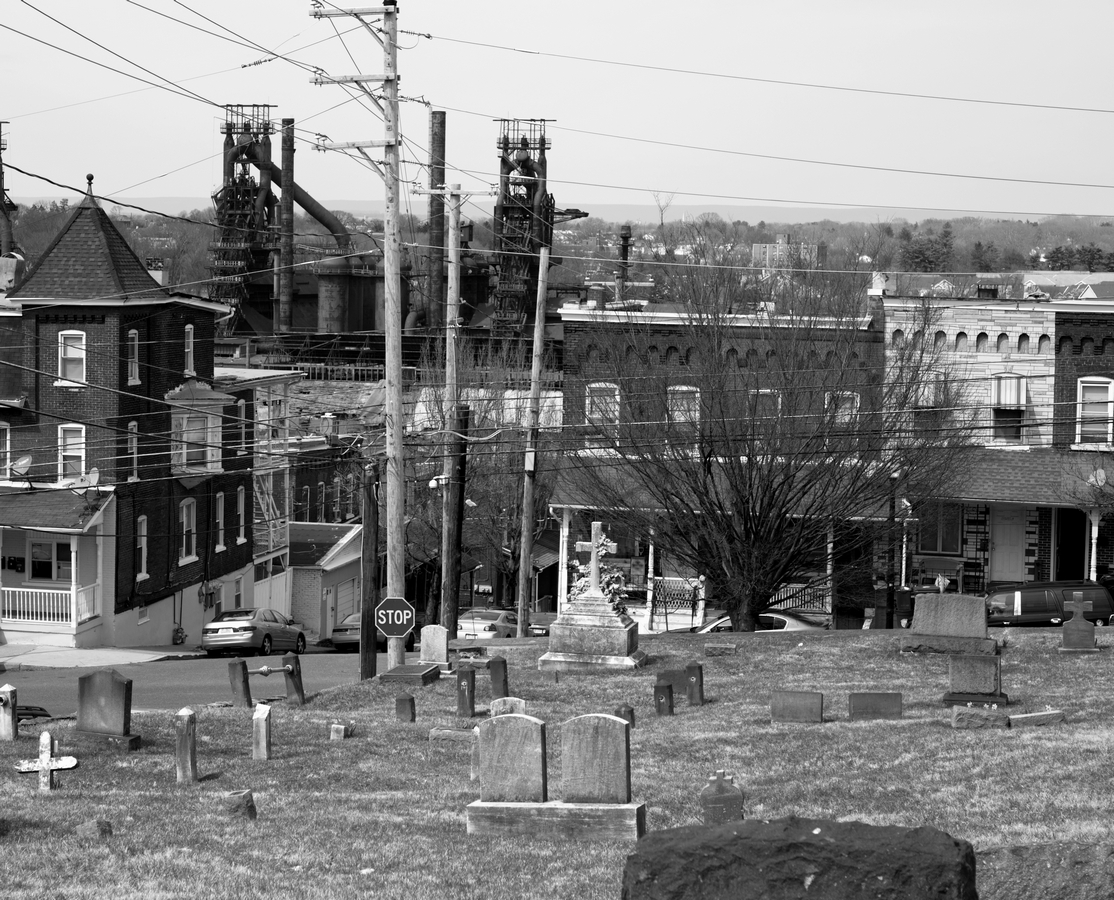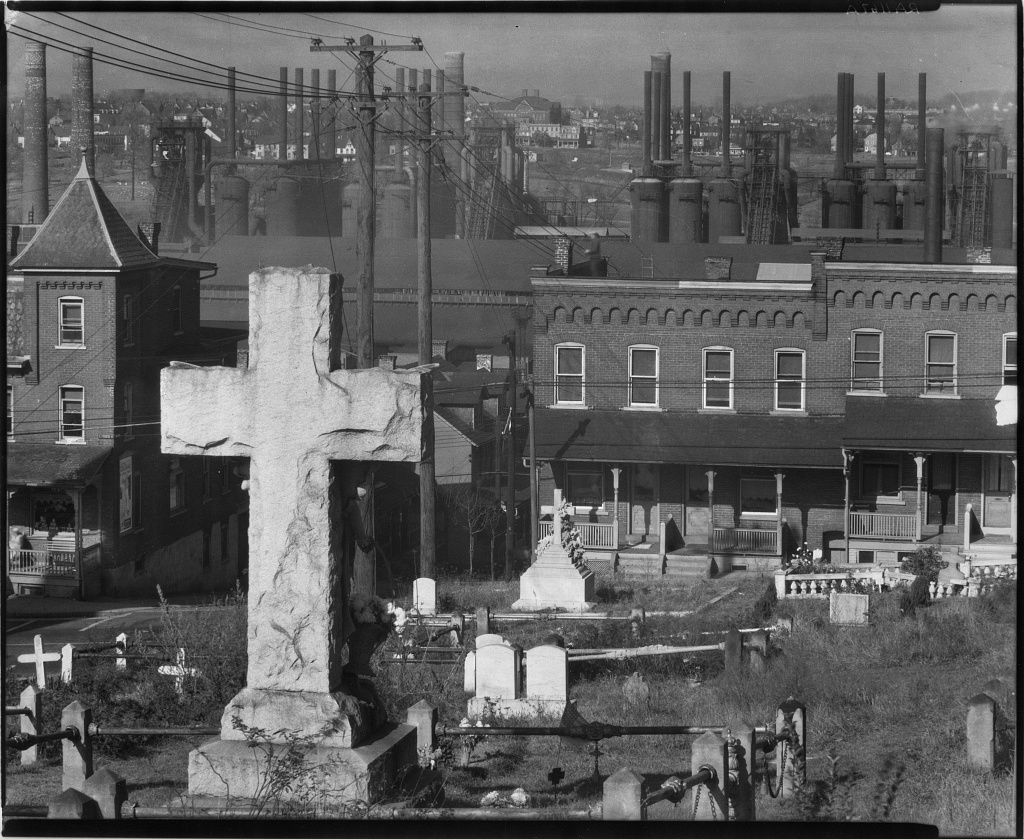Jerry Snyder
About the Image(s)
The image was taken in on a bright early spring day from a cemetery in Pennsylvania.
I was attempting to locate the same point of view as a previous photographer. This was my third or fourth visit to this place. Do you recognize this place? The exposure settings were 1/250 s, f/8, ISO 100.
This round’s discussion is now closed!
13 comments posted
(Groups 83 & 87)
Walker Evens - Cemetery, Bethlehem, Pennsylvania , ca. 1935-1938.
But I was not familiar with this particular piece and had to complete a Google Search of your photo to find this information.
Actually, I like your piece, too, for its broad sweep in documenting this vernacular architecture in this city. Posted: 11/05/2020 10:09:35
But I was not familiar with this particular piece and had to complete a Google Search of your photo to find this information.
Actually, I like your piece, too, for its broad sweep in documenting this vernacular architecture in this city. Posted: 11/05/2020 10:09:35
Thanks for your feedback. I'm curious if the Google search found my specific image or other similar images. The Walker Evans image is titled A Graveyard and Steel Mill, Bethlehem, Pennsylvania (November 1935). Here is Mr. Evans' image. The large cross is gone, but many identifiable features remain and allowed me to identify the approximate point of view. Someone planted a tree in the line of sight of the row houses, which is understandable since many photographers have attempted the same thing. As a result, my image was taken in April before the tree leafed out. Posted: 11/06/2020 07:15:13
(Groups 83 & 87)
Google (image) Search found "A Graveyard and Steel Mill". Posted: 11/08/2020 19:04:32
I am not sure what the subject is and feel, unfortunately that it is more of a snap shot requiring me to figure out the story. It is not simple and easy to look, since it is so busy with various details. It does have nice old film feel. Posted: 11/09/2020 13:11:42
I like Jerry's rendition better. It simplifies the subject. Posted: 11/09/2020 13:14:16
I certainly recognise blast furnaces, having been brought up a couple of miles from a large steel factory.
The first thing I saw was the "Stop" sign - candidate for removal?
The difference between the photos is interesting. The large number of wires in the recent one spoils it a lot I think. However some items in the steel plant have been demolished now by the look of it, and so the blast furnaces are much clearer and more interesting in your photo. People living in the close proximity of such plants, when the air would be heavy with dust and smoke, suffered lots of health problems, so the cemetary is quite relevent and makes a strong story. Pity about those wires.
Posted: 11/09/2020 13:14:23
The first thing I saw was the "Stop" sign - candidate for removal?
The difference between the photos is interesting. The large number of wires in the recent one spoils it a lot I think. However some items in the steel plant have been demolished now by the look of it, and so the blast furnaces are much clearer and more interesting in your photo. People living in the close proximity of such plants, when the air would be heavy with dust and smoke, suffered lots of health problems, so the cemetary is quite relevent and makes a strong story. Pity about those wires.
Posted: 11/09/2020 13:14:23
John, the image is a "Then and Now" project. It was also an exercise in locating the POV of the original image from the relative positions of the remaining elements in the scene. It will make more sense if you look at the historical photo attached to my reply to Mr. Lance Lewin above. I purposely left out description of the location's historical roots in hopes that our group members would recognize it (St. Michael's Cemetery). I left the messy details in my image to contrast the then and now aspect. They are part of the story. It's interesting to see how historical photographs are sometimes judged by today's (camera club) standards. Posted: 11/10/2020 09:05:51
Thanks for the comment, Jerry. I usually, as in this case, try to do a review and comment without seeing what the dialogue has been so that I am not influenced by that conversation. I see in looking the dialogue what you are doing, but just seeing the image standing alone, I still think the same way. I will say that I was impressed with Mr. Evan's image for how it communicated to me very succinctly, so given that I see what you were trying to do, but wonder if you could have edited the image a bit differently to give a similar feel. I thought Evan's image had significant impact for me. Posted: 11/10/2020 09:38:31
An interesting project, to travel to the location of an historic image and document its change, not to create a work of art. I didn't recognize the place. Needed to see the original to appreciate what you were doing. The big cross anchors Evans' original. I wonder why it was removed. Posted: 11/12/2020 00:36:51
(Group 32)
This is a fantastically interesting project you are engaged in.
1. I agree that it is essential to see the original Walker Evans shot as part of this project.
2. Evans shot in bright sunlight, yielding bright whites and dark shadows, especially casting the side street into deep shade. Can you go back and try to shoot in that kind of light and at that time of day? That would hide those three cars on the side street to the left of the Stop sign.
3. I think Evans shot with a long lens, to compress together the cemetery, the houses, and the factories. I think you shot with a shorter lens, and do not have the same sense of compression--which incidentally I have seen in lots of cemetery/city shots to bring the contrasting areas of the dead the living closer together. If I am right about this and you agree, can you go back and shoot with a longer lens?
Again, this is a highly original project, and I hope you keep on with it. You may not agree with my comments, but I would love to see you continue this wonderful work, and I hope to see more of it. Posted: 11/12/2020 22:32:17
1. I agree that it is essential to see the original Walker Evans shot as part of this project.
2. Evans shot in bright sunlight, yielding bright whites and dark shadows, especially casting the side street into deep shade. Can you go back and try to shoot in that kind of light and at that time of day? That would hide those three cars on the side street to the left of the Stop sign.
3. I think Evans shot with a long lens, to compress together the cemetery, the houses, and the factories. I think you shot with a shorter lens, and do not have the same sense of compression--which incidentally I have seen in lots of cemetery/city shots to bring the contrasting areas of the dead the living closer together. If I am right about this and you agree, can you go back and shoot with a longer lens?
Again, this is a highly original project, and I hope you keep on with it. You may not agree with my comments, but I would love to see you continue this wonderful work, and I hope to see more of it. Posted: 11/12/2020 22:32:17
(Group 32)
Wow, am I late to this discussion, sorry. I hope there is still space for more. This lost a lot from the strong subject of the cross that is now missing, but if I didn't know about the cross this is still a strong story about a mining town. The busyness of the image is a plus to tell the story, the wires are important. You needed to have a steep hill in the street to make the story strong. The cemetery tell the end of the story. I immediately knew this was a mining town and guessed West Virginia, but it could be a lot of towns within a few 100 miles or so of where it really is. Well done. You told the story of those towns. Posted: 11/18/2020 11:25:05
Wow, am I late to this discussion, sorry. I hope there is still space for more. This lost a lot from the strong subject of the cross that is now missing, but if I didn't know about the cross this is still a strong story about a mining town. The busyness of the image is a plus to tell the story, the wires are important. You needed to have a steep hill in the street to make the story strong. The cemetery tell the end of the story. I immediately knew this was a mining town and guessed West Virginia, but it could be a lot of towns within a few 100 miles or so of where it really is. Well done. You told the story of those towns. Posted: 11/18/2020 11:25:06


